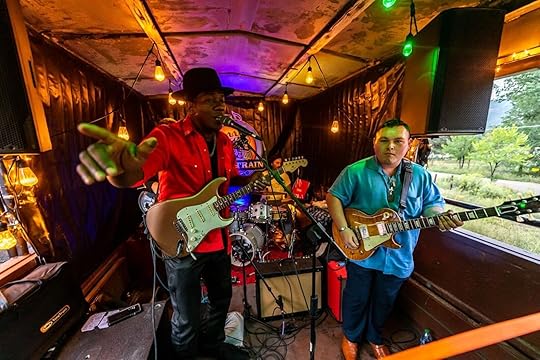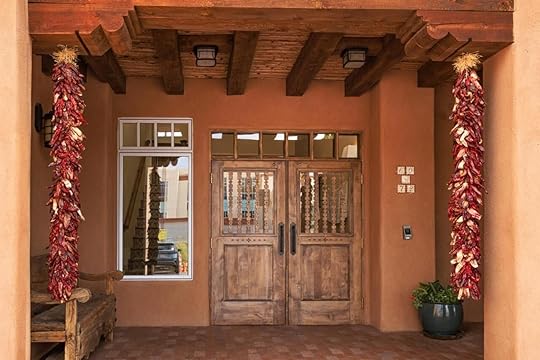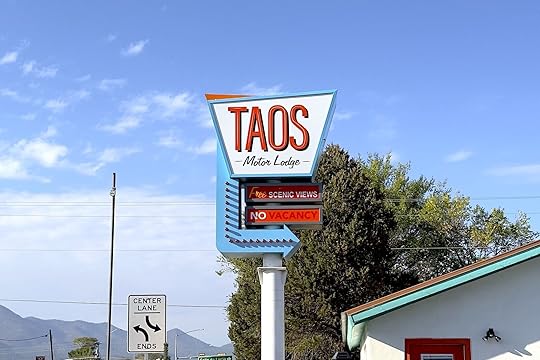Matador Network's Blog, page 26
July 14, 2025
Universal Orlando Resort Just Opened Three Incredible New Hotels – Here’s Which Is Right for You

After a six-year wait, Universal Epic Universe finally opened its portals in time for summer 2025. The fourth offering from Universal Orlando Resort, Florida, orbits around five themed worlds: The Wizarding World of Harry Potter (Ministry of Magic), Super Nintendo World, How to Train Your Dragon (Isle of Berk), and Dark Universe. The otherworldly Celestial Park unites the lands and sparked the imagination for those responsible for creating Universal Orlando’s newest hotels.
As the first theme park to open in the United States for over two decades, interest is off the charts and the scale of the quartet means you’ll need to spend at least a couple of days in Orlando. Co-owned and operated by Loews Hotels, three brand-new properties feature out-of-this-world amenities and such benefits as early park admission and free shuttle buses. One luxury hotel is located within park limits while two value resorts stand adjacent to the park, one being walkable. Here is the lowdown on the trio in terms of amenities, location, dining, and cost.
We hope you love the Universal Epic Universe hotels! Just so you know, Matador may collect a small commission from the links on this page if you decide to book a stay. Listed prices are accurate as of the time of publication.
Universal Helios Grand Hotel – where to stay for luxury Photo: Booking.com
Photo: Booking.com Photo: Booking.com
Photo: Booking.com Photo: Booking.com
Photo: Booking.comSee more photos
Part of the resort’s Signature Collection, Universal Helios Grand is the only hotel situated on the grounds of Universal Orlando’s latest theme park. In fact, a stay at this 500-room property comes with the perk of a dedicated on-foot entrance to Universal Epic Universe which is a great time saver.
Universal Helios Grand Hotel fuses Mediterranean charm with a touch of the extraterrestrial. Communal areas are adorned with cosmic patterns and constellations in reflection of the gateway world at Universal Epic Universe. Floral accents in the rooms create the sense of a botanical oasis with top-tier domains looking over the theme park, hotel gardens, or pool. Luxurious suites come with kitchenettes and plush lounges whereas families with younger kids can snap up a How to Train Your Dragon-themed suite.
This premium hotel has a resort-style zero-entry pool edged by rentable cabanas and a hot tub. A breakfast buffet is served in Flora Taverna with pizza, gyros, and Mediterranean bites available for lunch and dinner. There is also a grab-and-go bakery on-site, a casual poolside bar and grill, and a rooftop bar serving heavenly cocktails.
You’ll enjoy complimentary transportation to the four theme parks and Universal CityWalk plus streamlined access to the latest park via the dedicated entrance. Early park admission gives you a one-hour head start on the lines. Any merchandise purchased throughout the parks is delivered complimentary to the hotel while room keys carry resort-wide charging privileges.
Pros and cons of Universal Helios Grand Hotel
Luxurious (but expensive)Dedicated access to Universal Epic UniverseComplimentary shuttle buses to all parksWalkable to Universal Epic UniverseEarly admission to Universal Epic UniverseMerchandise deliveryPremium diningDeluxe and themed suitesAccessible roomsTipped towards an adult audience
Address: 8505 S. Kirkman Road, Orlando, Florida 32819
Nightly rates: from $400 (subject to season)
 Photo: Booking.com
Photo: Booking.com Photo: Booking.com
Photo: Booking.com Photo: Booking.com
Photo: Booking.comSee more photos
Three, two, one, blast off. Falling under the Prime Value collection, Universal Terra Luna Resort is a lunar-inspired hotel stationed on the south side of the long-awaited Florida theme park. Another offering from the award-winning Universal Creative team, the 750-room Terra Luna features comparable perks to the Universal Helios Grand Hotel with early park admission and complimentary shuttles being the most crucial.
Comfortable rooms have a spaceship-style window and terrestrial tones. They come as family rooms as standard, with all units equipped with two queen beds and a maximum occupancy of four. As with the other two properties, Universal Terra Luna Resort has a wide offering of accessible rooms catering to those with mobility and hearing concerns.
The zero-entry swimming pool features pop-up jets and has a poolside movie theater. There is also a hot tub and fire pit area perfect for downtime between park adventures. Breakfast, lunch, and dinner are served at the Omega Cafe and Market while the lobby bar impresses with its lunar-inspired cocktails. Burgers, comfort food, and refreshments are available at the poolside Moonrise Grill and Bar.
Pros and cons of Universal Terra Luna Resort
Affordable (this is the cheapest hotel near Universal Epic Universe)Family-friendlyFree pack ‘n’ playsAccessible roomsSpace-themed decorHas a pool, hot tub, and poolside moviesComplementary shuttles to parksEarly admission to Universal Epic UniverseNot walkable to Universal Epic Universe\Food is limited
Address: 5500 Epic Blvd, Orlando, Florida 32819
Nightly rates: from $160 (subject to season)
 Photo: Booking.com
Photo: Booking.com Photo: Booking.com
Photo: Booking.com Photo: Booking.com
Photo: Booking.comSee more photos
Another Prime Value property, Universal Stella Nova Resort is the best mid-range hotel near Universal Epic Universe. Located across the road from Terra Luna, the rooms share a similar aesthetic inspired by galaxies far, far away with spaceship windows and cosmic decor. But here, the exterior is particularly eye-catching with 140,000 iridescent stainless‑steel tiles dazzling under the Floridian sunshine. An entry portal modeled on a swirling black hole leads you to the lobby bar where cocktails take a turn for the theatrical. Up on the third floor, a starry canopy provides a stellar backdrop for family selfies.
As with its sister, all 750 rooms at Stella Nova come with two queen beds and there is a large supply of accessible rooms. The hotel has a 10,000 sq ft resort‑style pool with a splash pad and sand pit for kids plus a massive recreation room, hot tub, fire pit area, and gym. Cosmos Cafe and Market is a one-stop shop for breakfast, lunch, and dinner anchored on North American classics. Galaxy Bar and Galaxy Grill offer poolside service and there’s a special in-room pizza service which is always appreciated after a long day.
A dedicated walking path gets you to Universal Epic Universe in 15 minutes or less.
Pros and cons of Universal Stella Nova Resort
AffordableFamily-friendlyAccessible roomsSpace-themed design and fun photo opsHas a pool, splash pad, hot, tub, and recreation roomComplementary shuttles to parksWalkable from Universal Epic UniverseEarly admission to Universal Epic UniverseAddress: 4500 Epic Blvd, Orlando, Florida 32819
Nightly rates: from $215 (subject to season) 
Riding the Rails: the Durango Blues Train Is a Rolling Dance Party

The relationship between blues music and railways in the United States is one that goes way back, rooted in both the social and cultural dynamic of the early 20th century. In the late 1800s and early 1900s, trains were more than just a mode of transportation: they were a symbol of freedom, migration, and the opportunity to make your own way, especially for Black Americans making their way across the country. And in southwestern Colorado, one unique summer activity is putting a new spin on the connection between blues music and seeing the countryside by train.
The Durango Blues Train transforms what would be a historic rail journey into a kinetic blues festival, rolling through some of the state’s most dramatic scenery. Every May and August, the train draws music lovers and rail enthusiasts alike to board the coal-fired, steam-powered Durango & Silverton Narrow Gauge Railroad for a 3.5-hour moving concert through the canyons of San Juan National Forest. Each of the six vintage cars hosts a different live blues act, and passengers are invited to roam between them as the train chugs through the mountains. Four cars have seating to watch the bands, while the other two have room to dance. The experience is as much about the journey as the music, as the train covers around 19 miles along the Animas River, passing craggy cliffs and pine forests. It also hosts non-music experiences, like the popular Polar Express winter tour.
View this post on InstagramThe history of the Durango Blues TrainA post shared by Durango Blues Train (@durangobluestrain)
The Durango & Silverton Narrow Gauge Railroad is a living artifact of Colorado’s mining era. It was built in 1881 by the Denver & Rio Grande Railway to haul silver and gold ore from the San Juan Mountains. The narrow gauge rails, spaced just three feet apart, allowed it to better navigate tight turns and narrow routes through rugged terrain. By July 1882, it connected to Silverton, Colorado, and carried both freight and passengers. Even when the mining industry waned, it kept running as a scenic activity. Today, it’s a National Historic Landmark and a National Historic Civil Engineering Landmark.
Unfortunately, the 2025 concerts are already sold out. So if you want to attend, you’ll need to mark your calendar for February of 2026, when tickets for next year are likely to go on sale. Or, you could pick up tickets for a similar event. While the Blues Train is no doubt a unique experience, it’s not the only musical event rolling along historic rail lines.
In Australia, the Queenscliff Blues Train offers a similar blend of live music and rail travel along the Bellarine Rail Trail, with four acts and stops along the way. At each stop, you’ll switch which car you’re in, letting everyone on board experience all four shows. It’s just outside Melbourne and runs show sporadically throughout the year.
View this post on InstagramA post shared by The Blues Train | Bellarine Peninsula | Australia (@thebluestrain)
Music fans who would prefer to stay in the US should head to central California, where the Yosemite Jazz Train beckons those who love both live music and the park’s natural beauty. Held on select Sundays throughout the summer, the event isn’t a concert on wheels, but instead, a two-part experience. Guests will ride the historic Yosemite Mountain Sugar Pine to the Lewis Creek Amphitheater for a hidden concert surrounded by Sierra Nevada forest, followed by a meet and greet before the return trip. The train departs from Fish Camp, just four miles south of the Yosemite National Park southern entrance.
View this post on InstagramA post shared by Arthur Thompson (@arthurleethompson3)
In New Mexico, the “Sunset Serenade” tours depart from the Santa Fe Depot and travel along a historic rail line through open desert, passing mountain vistas and the Galisteo Basin Overlook. Along the way, there’s live entertainment and local musicians, creating a festive atmosphere in the vintage 1937 railcars. On select dates, you may even find flamenco performances or themed sing-along sessions. There’s seating both indoors and outdoors, plus bar service and open-air cars so you can catch both the sunset and early evening stargazing. 
View this post on InstagramMore like thisTrain Travel7 Vintage Train Rides in the US That Will Take You Where No Cars Can GoA post shared by Sky Railway | Santa Fe’s Adventure Train (@skyrailway)
Hong Kong Turned Part of Its Old Airport Into a Covid Facility. Now It’s a Hostel and Cultural Destination.

Travel is a source of creative inspiration for many. What happens when thousands of creatives from around the world gather in one place? Hong Kong is about to find out, following the September opening of the Runway 1331, a former COVID-19 containment barracks turned youth hostel and startup/creativity incubator at the site of the city’s old airport.
Runway 1331, according to the South China Morning Post, is named after the runway of the old Kai Tak airport, and consists of 3,000 rooms with private bathrooms that were built for sequestration during the pandemic but have since fallen empty. The hope is that motivated young people, both from the Guangdong-Hong Kong-Macao Greater Bay Area and beyond, will inhabit the rooms and use the space as an incubator for startups, sports, music, art, and other creative endeavors. While final details on renting the units are forthcoming, it appears travelers will be able to stay at Runway 1331 to bring, and gain, inspiration of their own.
“This is the centennial anniversary of the old Kai Tak airport. Runway 1331 will integrate arts, culture, sports and innovation to create a unique cultural hub and provide a runway to Hong Kong youth,” said entrepreneur Winnie Chiu Wing-kwan, who backed the project alongside the Hong Kong government, to the South China Morning Post.
The two financiers founded a joint venture, Glorise Tourism and Culture. Arts and sports organizations, alongside small businesses, are encouraged to host space in the venue and screen applicants who can receive free housing in exchange for collaboration. The facility is currently operating at a limited capacity during a test run, according to news site The Standard, with rooms starting at HK$200 (about $25) per night.
Hong Kong residents as well as foreigners can apply for residency once the full project opens in September, with the property expecting at least half of the units to be occupied by people between ages 19 and 40. One-, two-, and three-bedroom units will be available. The site is near both the city’s cruise terminal and will have bus access to the nearest MTR rail station. 
Only Hotel on North Rim of Grand Canyon National Park Destroyed in Fire

A wildfire burning within Grand Canyon National Park destroyed one of the most historic buildings in the entire national park system, according to park officials.
The White Sage Fire and Dragon Bravo Fire, collectively called the “Grand Canyon fires,” were both started by lightning strikes in early July 2025. As of July 14, both are zero percent contained. On July 13, park officials confirmed that the Dragon Bravo Fire, currently at 5,716 acres, had completely destroyed the historic Grand Canyon Lodge. It was originally built in 1928 by the Union Pacific Railroad to bring tourists to the park, and designed by architect Gilbert Stanley Underwood. He was (and still remains) the country’s most well-known national park architect, having also designed the Old Faithful Inn in Yellowstone National Park, Bryce Canyon Lodge in Bryce Canyon National Park, and the Ahwahnee Hotel in Yosemite National Park.

Staff of the Grand Canyon Lodge in summer 1930. Photo: NPS/Public Domain
Though the original structure was destroyed by fire in 1932, it was quickly rebuilt and reopened in 1937. It was the only hotel on the North Rim of the national park, and was a shining example of national park architecture from the 1920s, or “parkitecture,” with massive stone columns, log ceilings, and large decks and windows overlooking the canyon. It was built in a time when the Union Pacific Railroad was developing destination tourism through its “Loop Tour,” offering package deals that linked parks like Zion, Bryce, and the Grand Canyon via rail and motorcoaches.
In the 1980s, it was listed on the National Register of Historic Places, both for its architecture and its role in shaping early Western tourism. Unlike many park lodges that saw significant updates, much of the lodge was left intentionally rustic to preserve its historic character. It was one of the most popular lodges in the National Park System, usually booked out months in advance.
In addition to destroying the Grand Canyon Lodge, the fire has also destroyed between 50 and 80 other buildings and cabins, including a visitor center and other historic buildings. Because the fire is not contained and still spreading thanks to strong winds, the park already announced that the North Rim will be closed for the remainder of the season, which normally runs through mid-October. Also closed are trails and campgrounds in the area, including the North and South Kaibab trails, Phantom Ranch, and the Bright Angel Trail beneath Havasupai Gardens.
With the complete loss of the Grand Canyon Lodge, visitors to the North Rim now have no lodging options within the park, other than camping. The closest lodging is Kaibab Lodge, about five miles from the park entrance, with rustic cabins and a small restaurant. The next option is the Jacob Lake Inn in the town of Fredonia, roughly 45 miles north of the North Rim. But the closest town with any type of tourist facilities is Kanab, Utah, a solid two hours from the North Rim entrance.
For visitors who had reservations at the lodge, park concessionaire Forever Resorts noted that it will be reaching out with refunds and details on cancellations. “As stewards of some of our country’s most beloved national treasures,” wrote a fire update from the resort, “we are devastated by the loss of the Grand Canyon Lodge and numerous other historic buildings at the Grand Canyon’s North Rim.”

Yellowstone National Park’s Old Faithful Inn. Photo: Nagel Photography/Shutterstock
Though several of the country’s most historic national park lodges have been destroyed by fires, including Glacier National Park’s treasured Sperry Chalet. Others have been rebuilt, demolished, or repurposed. Fortunately, more than a dozen still remain throughout America’s 63 national parks.Old Faithful Inn (Yellowstone National Park): Built in 1904 and considered the largest log structure in the worldThe Ahwahnee (Yosemite National Park): Yosemite’s crown jewel, finished in 1927 and blending Art Deco, Native American, Middle Eastern, and Arts and Crafts design influencesEl Tovar Hotel (Grand Canyon National Park): Opened in 1905, making it one of the first major lodges in the park systemBright Angel Lodge (Grand Canyon National Park): Built in 1935, with a similar log-and-stone aesthetic as Grand Canyon LodgeParadise Inn (Mount Rainier National Park): Opened in 1917 and a classic example of rustic alpine lodge designLake Crescent Lodge (Olympic National Park): Built in 1915 overlooking Lake Crescent, with antique furniture and wraparound porchesCrater Lake Lodge (Crater Lake National Park): Opened in 1915 and extensively restored in the 1990s to preserve its original lookGlacier Park Lodge (Glacier National Park): Built by the Great Northern Railway in 1913 and known for its massive timber lobbyMany Glacier Hotel (Glacier National Park): A Swiss-style chalet built in 1915 to attract wealthy summer tourists by railLake McDonald Lodge (Glacier National Park): A slightly more affordable option, completed in 1914 and designed with a similar Swiss-alpine aestheticZion Lodge (Zion National Park): Also designed by Underwood and built in 1925, though it was rebuilt in a similar design following a 1966 fireChisos Mountains Lodge (Big Bend National Park): A slightly later build, constructed in the 1940s by the Civilian Conservation Corps (CCC)Bryce Canyon Lodge (Bryce Canyon National Park): Yet another Underwood design, finished in 1925 and still standing in its original form todayPhantom Ranch (Grand Canyon National Park): A preserved backcountry lodge completed in 1922 and accessible only by foot, mule, or raftBig Meadows Lodge (Shenandoah National Park): Another CCC project with a rustic stone-and-timber design, finished in 1939Skyland Lodge (Shenandoah National Park): One of the oldest lodges in a park (1895), predating the park itselfThe Inn at Death Valley (Death Valley National Park): Opened in 1927 as the Furnace Creek Inn to attract tourists riding the Tonopah & Tidewater RailroadLeConte Lodge (Great Smoky Mountains National Park): Established in 1925 and still in operation as a hike-in-only backcountry lodge
 More like thisNational ParksTaking a National Park Trip? Here’s Why You Should Stay Inside for at Least One Night.
More like thisNational ParksTaking a National Park Trip? Here’s Why You Should Stay Inside for at Least One Night.
How a Balance Bike Can Jumpstart Your Toddler’s Love for Family Bike Trips

I only had a faint idea of what growing up in Colorado entailed when my daughter, Margot, was born in 2022. My wife and I are from California’s central coast and moved to Denver after five years in New York City. What I did know about Colorado is no secret: people here know their way around the outdoors, and there only seem to be upsides to getting our kid started early. Part of that, for us, included having our daughter be confident on a bike before enrolling in kindergarten.
My mom is a lifelong educator and suggested Strider balance bikes. Ryan McFarland started the company in 2007 in Rapid City, South Dakota, and Strider has sold more than 4 million bikes around the world since then. When I spoke with the company in November, a representative mentioned Margot could be riding her Strider as early as spring if she practiced through the winter.

Photos: Nickolaus Hines
Research backs the benefits of a balance bike. One study found that kids who used a balance bike learned to ride a traditional bike at about 4 years old. With training wheels, the average was about 6 years old. Another retrospective study also found that balance bikes lead to independent cycling faster than training wheels, and that balance bikes better develop posture control.
Balance bikes aren’t new. In fact, they predate the pedal bike: the first was called the Dandy Horse, built in 1817 — more than 40 years before the first commercial bikes with pedals. McFarland came to his design for Strider while creating a bike that would fit his 2-year-old son. The children’s bike designs he encountered at the time were too tall and too heavy. In short, they were something to grow into rather than ride immediately.
So McFarland started cutting back: the upper half of the frame, the handlebars, the seat height. That made the pedals out of proportion and they couldn’t be scaled down enough and remain useful.
“I simply removed them,” McFarland says. “Coming to terms with that was a breakthrough moment because it caused me to ask if it would still be a bike. What I learned is that the pedals are simply a means of propulsion, the bike is the frame, seat, wheels, and handlebar that can be ridden while balanced. Therefore, all items with a frame, seat, handlebar, and two wheels become one class, from a balance bike to a pedal bike to a motorcycle. They all balance and steer in the same manner, they simply differ by what propels them. In the case of a 2-year-old, the best means of propulsion was walking/running.”
The learning process begins with sitting on the bike, walking with it between the legs, and moving the bike from side to side. Next, kids sit and push with their feet, progressing to resting their feet on the footrests while leaning into turns. The final stage is independently balancing and gliding, steering comfortably with their feet lifted. From there, it’s a quick transition to a pedal bike.

Photo: Nickolaus Hines
In November, just after Margot’s second birthday, I helped her sit and balance as I steadied her new banana-yellow Strider bike. By her third attempt about a week later, Margot said she wanted to do it by herself, and she naturally started walking with the bike between her legs. She went farther and farther each day. When winter kept her inside, she practiced in the hallway until that became a hazard to our walls. Finally spring came and Margot would hand us her helmet half the time we were in the backyard so she could practice by herself. Day or night, whether she was in a dress or a diaper or a robe, she wanted on her Strider bike. Now at 2-and-a-half, she still needs help buckling her helmet. But she’s just getting started lifting her feet onto the footrests and gliding.
I’ll of course never know how fast she would have picked things up with training wheels. Aside from climbing and now riding, she’s generally cautious about pushing herself physically (a blessing for any parent keeping up with the cost of Band-Aids). Riding is an area where we’ve been able to give her a head start, preparing her for many family bike trips ahead.
I caught up with McFarland to learn more about Strider’s origins, improvements on the first prototype, and what’s coming up from the company.

Photo: Strider
Matador Network: How did your own parenting experience shape the early design and further iterations?Ryan McFarland: I am an avid bicycle and motorcycle rider, so I was motivated to encourage my son on his bike. I also encouraged adventurous riding such as little dirt trails, going over tree roots, riding through puddles. Because of this, I was more aware of his interaction with the original [Strider] bike and how it could be improved.
One of the early realizations is that he easily learned the Basic Balanced Riding skills of how to sit on the seat and stride along, but he could also learn Advanced Balanced Riding techniques if I added some footpegs like on a motorcycle. This would allow him to stand on the pegs while gliding and absorb terrain and maneuver the bike. So the first prototype after his initial bike focused on the foot position for standing riding.
What was the biggest challenge in developing a bike without pedals that still felt “complete” to a child?It has never been an issue for a child — until an adult tells them it isn’t a “real bike” or something like that. In reality, this is where the child is smarter than the adult.
The Strider is a more capable machine than a tricycle or a 12” bike with pedals and training wheels. The Strider is much lighter. The striding action lets a child develop more power using their full leg motion (not just a tiny pedal circle), the combination allows the Strider to go on nearly any terrain where other trikes and bikes are limited to flat concrete. So, the biggest challenge is to get adults to let go of their misguided, traditional ideas of what a good child’s bike really is.

Photo: Strider
How does starting with a balance bike affect a child’s coordination or motor development long-term?Trikes and Bikes with training wheels don’t teach balance. They actually shield a child from balance, delaying the child’s ability to even experience what they are trying to learn. The steering also functions differently based on whether a child is on two wheels leaning into turns, or on three or four wheels and subject to centrifugal forces to the outside of a turn.
Scientific studies have confirmed that children who start on balance bikes and avoid all three- and four-wheel options, end up independently pedaling a two-wheeled standard bike two years sooner than kids who use a tricycle or training wheels. And two years at that young age is a significant life percentage. The difference is four years versus six years to be independently riding.
At what age range do you typically see the most success in kids adapting quickly to a Strider Bike?Kids can learn to ride a Strider Bike as soon as they can walk because they’ve already learned the means of propulsion for the bike. We say that kids between 1 and 3 years old can intuitively pick up a Strider 12″ Balance Bike and start riding it right away. The skill development timeline of each child will always be unique to them, but the point of the bike is that it’s simple to learn on from a very young age.
Realistically, kids who are even younger can get started on the basics of riding, which is why we developed the Strider 2-in-1 Rocking Bike. They may not be strong enough on their own two feet to walk just yet, but by 6 months old, they can grip the handlebars, stand on the rocking base (or sit on the seat) and rock back and forth. That’s introductory riding, too!
What should parents do if their child isn’t picking up balancing as quickly as others?Just cheer them on! Everyone learns at their own pace. Don’t pressure them. Keep the bike available and fun. It may help some children to watch others on bikes as a source of motivation and learning.
View this post on InstagramHow has Strider shaped or responded to the rise of kid-focused biking culture, like family trail riding and bike parks?A post shared by Strider Bikes (@striderbikes)
I believe Strider has contributed greatly to the family bike culture, mainly because we have proven through our performance design that kids can ride and do much more than ever thought possible if given the right tool for the job. Young kids can now go more places, ride more difficult terrain, and do it independently of assistance than ever before. We hear from many families that the young Strider rider has been so mobile and fast on their little bike that the rest of the family had to buy bikes just to keep up.
What does it feel like to see Strider races or tiny kids bombing down trails around the world on your bikes?After nearly 20 years, that never gets old. Part of that is because, after 50 years of riding on two wheels myself, I know how much fun and adventure lies ahead for them and I can see that little flame is already lit and only going to grow brighter
Are there any upcoming innovations or products Strider is developing to further support early riders?Yes, but if I told you, I’d have to silence you. Stay tuned!! 
Where to Play, Eat, and Stay in Bellevue, WA, From the Sea to the Sky

I could see our hotel from here — but when you’re paragliding during an adventure-focused weekend in Bellevue, Washington, you can see a lot of things. Bellevue may be just a short drive from Seattle across Lake Washington, but it’s carving out its own identity: an eco-friendly city with just as much access to dining and shopping as it has to breathtaking nature.
As a Pacific Northwest native who just returned home from seven-plus years living the expat life in Budapest, this exciting Bellevue excursion was the perfect opportunity for me to rediscover home. (Some call Bellevue the ideal base camp for exploring Washington State, after all.) Whether you’re a first-time or repeat visitor — or you’re revisiting your old stomping grounds, like I was — Bellevue’s activities from the sky to the sea are an unforgettable gateway to both adventure and leisure in the Pacific Northwest.
Things to do in Bellevue for outdoor enthusiastsHike around the Coal Creek Natural Area
Photo: Roman Khomlyak/Shutterstock
Washington’s forests hold secrets for those willing to seek them out, and the Coal Creek hike is one nice option (Bellevue has over 73 trails and over 100 parks). This well-groomed trail takes you past pieces of Washington’s industrial history, with remnants of a once-booming mine.
My group’s guide from the ethical travel company Global Family Travels spoke with enthusiasm about nature and compassion for all who were tied to the land. As we moved through the lush greenery — always sticking together, as there are bear and mountain lion sightings — the hike fondly reminded me of elementary school field trips where we’d look at flora and fauna along state park trails. Except this time, we were also looking at coal mine shafts and overgrown railroad tracks. By the end of the tour, I’d learned about a piece of Washington’s coal mining history, and how the past still affects recovery efforts today.
Coal Creek Natural Area: Coal Creek Parkway, Bellevue, WA 98006
Explore the city and its trails on an e-bikeBikeHop is an e-bike rental service that currently partners with three hotels in the Bellevue area — Courtyard Seattle Bellevue/Downtown, Hyatt Regency Bellevue, and InterContinental Seattle Bellevue — to provide guests with complimentary access to wheels. On my e-bike excursion, following the forest trails with towering evergreens growing on all sides, it was easy to forget we were in a city. Although we took a nature route (there are trails that take you to the lakes or past the Bellevue Botanical Garden, among other places), the bikes are also suited for a city adventure, like exploring the cute shops and cafes of Downtown Bellevue. Download the Bellevue Bike Map for guidance on where to go.
BikeHop: 11100 NE 6th St, Bellevue, Washington 98004
Things to do in Bellevue for adrenaline seekersTake to the skies in a seaplane
Photo: Denae Mcgaha
The airplane-hangar-turned-office belonging to Northwest Seaplanes was my group’s first stop on our seaplane tour. Our cheerful yellow seaplane seated six, plus our captain, and after a brief safety orientation, we were on our way. It was one of those rare Northwest days where the sun is strong and the winds are fair — perfect sightseeing conditions.
Once airborne, our pilot (retired after 30 years of flying United) served as both navigator and tour guide. Stories came through our headsets as he pointed out the Space Needle, Mount Rainier, the Bellevue skyline, Bill Gates’ compound, and more. I found myself tearing up as I took in my home from above. Everything from the snow-capped mountains to the sparkling Puget Sound reminded me why the area draws over 40 million visitors a year. It reminded me how lucky I am to call this place home.
Northwest Seaplanes: 860 W Perimeter Rd #5346, Renton, WA 98057
Get your thrills paragliding
Photo: Denae Mcgaha
Just a 20-minute drive from Bellevue, Issaquah’s Poo Poo Point has some of the top conditions for paragliding in the whole US. This makes it a huge draw for paragliders and schools like Northwest Paragliding. Anticipation built during our quick shuttle ride to the top of Tiger Mountain, where we found one of the most breathtaking vistas of the trip so far. Blazing sun, blue skies dotted with colorful chutes, and a steady breeze made for perfect conditions.
Our guides’ enthusiasm was infectious, and after a brief orientation and some paperwork, it was time to get strapped in. Somehow, the nerves didn’t hit until I was standing at the edge. But feeling the tug on my hip harness as the parachute billowed with air, I knew there was no going back. With my instructor in my ear, I started to run forward. One step, two steps, three steps — before I knew it, there wasn’t any ground left. We were flying. After a peaceful flight, instructors and other students waited at the landing site, with shade and ice-cold water at the ready.
To pair with our high-flying adventure in Issaquah, we stopped at the Well and Table to replenish our strength. This woman-owned restaurant is farm-to-table in the truest sense, crafting meals with the freshest of fresh ingredients.
Northwest Paragliding: 475 Front St S, Issaquah, WA 98027
Things to do in Bellevue for leisure loversSpend a day wine-tasting in Woodinville
Photo: Denae Mcgaha
With over 200 new wineries in Washington opening over the past decade, the state’s wine scene is booming, and Bellevue is the perfect gateway for a day trip to wine country. Neighboring Woodinville is a once-rural town now leaning into wine and whiskey tourism.
One winery that takes its heritage seriously is Chateau Ste. Michelle, which can trace its roots back to the repeal of Prohibition. In the century since, it’s left its mark on the wine world (it’s the largest single producer of Riesling in the world, after all). Book a spot in the tasting room to sample any of the winery’s signature wines, or upgrade for the Somm’s Table experience: a five-flight tasting with Washington-sourced pairings, introduced by the chef herself. As we tasted our way through the five wines, our sommelier wove stories and history into each glass.
Latta Wines was our next stop for a deep dive into more undiscovered tastes of Washington. Latta is the ongoing result of a love affair with unique Washington varietals, and each small production bottle has a story behind it. As we sat beneath the soaring ceilings of Latta’s Woodinville tasting room (it also has a location in Seattle), the tasting menu we enjoyed showed off the best of the state.
Chateau Ste. Michelle: 14111 NE 145th St, Woodinville, WA 98072
Latta Wines: 14200 NE 145th St, Woodinville, WA 98072

Photo: Michael J Magee/Shutterstock
Summer in Bellevue is synonymous with lake life, so after a deliciously flavorful meal at the Michelin-recommended Jiang Nan, we pulled into Meydenbauer Bay. The bay was buzzing with stand-up paddleboarders, boaters, and the like, but our Duffy boat eased out of the marina silently — thanks to the eco-friendly design that has it running on golf cart batteries.
Our guide took us past some of Washington’s most coveted real estate (including Bill Gates’ compound). We even spied a real T. rex skeleton on display in one house’s floor-to-ceiling windows. With bald eagles swooping to catch their dinner in front of a backdrop of Mt. Rainier, it’s hard for the Bellevue Lake Cruise to get more quintessentially Washingtonian. With the right weather and the right company, this pleasure cruise on Lake Washington is the perfect way to sit back, relax, and see Bellevue from the shoreline.
Bellevue Lake Cruise: Meydenbauer Bay Park 2 99th Ave NE Bellevue, WA 98004
Shop, dine, repeat at Bellevue Square
Photo: Colleen Michaels/Shutterstock
With over 200 shops and restaurants, Bellevue Square is one of the largest shopping centers in Washington State. You can transition seamlessly from daytime to evening by grabbing dinner at one of the many restaurants or heading downstairs to the speakeasy-esque cocktail bar Civility and Unrest for a nightcap.
Bellevue Square: 575 Bellevue Square, Bellevue, WA 98004
Where to eat and drink in BellevueAscend Prime Steak and SushiView this post on InstagramA post shared by Ascend Prime Steak & Sushi (@ascendprimebellevue)
One night, after welcome cocktails at the stylish W Hotel, we crossed Bellevue Square to arrive at the evening’s main event: dinner at Ascend Prime Steak and Sushi. An elevator ride 31 floors up delivered us to stunning views of Pacific Northwest vistas, from Mount Rainier to Lake Washington and a blanket of evergreens on all sides — a reminder that even though Bellevue is a city, nature really isn’t far away at all.
Dining privately in the Vertigo room afforded us floor-to-ceiling window views, but all tables at Ascend have some visual access to the Pacific Northwest’s stunning scenery. Everything about Ascend’s menu is indulgent, from the melt-in-your-mouth Wagyu to the lusciously crafted sushi and the top-shelf curated drinks list. Just make sure to save room for dessert.
Ascend Prime Steak and Sushi: 10400 NE 4th St Ste 3100, Bellevue, WA 98004
Bellevue Brewing CompanyView this post on InstagramA post shared by Bellevue Brewing Company Spring District Brewpub (@bellevuebrewing)
Washington’s geography makes it heaven-on-earth for craft brewers, and Bellevue Brewing Company wasted no time in bringing that to Bellevue. As Bellevue’s first locally owned craft brewery, Bellevue Brewing Company is an anchor in Bellevue’s Spring District, the city’s trendy urban core. Snag a seat on the patio to drink with a view of the brewers in action, or drink indoors among the art gallery that shows the history of brewing in the area. Either way, make sure to explore the brewery’s food as well as its drinks — all of the gastropub dining options are bursting with flavor.
Bellevue Brewing Company: 12190 NE District Wy, Bellevue, WA 98005
Monsoon BellevueView this post on InstagramA post shared by Monsoon (@eatdrinkmonsoon)
This Vietnamese staple on Bellevue’s tree-lined Old Main Street is one of the reasons the street is known as a dining destination. The sunny venue serves Vietnamese flavors influenced by the Pacific Northwest. Monsoon’s dishes are bright, fresh, and popping with color (I’m still thinking about how its phở was the most flavorful I’ve ever had). Afterward, pop by Matcha Magic across the street for a sweet treat or neighboring Browne Wines
for a digestif.
Monsoon Bellevue: 10245 Main St Unit 103, Bellevue, WA 98004
Cantina Monarca
Photo: Denae Mcgaha
For our farewell dinner, we headed back to Bellevue Square. This time, instead of heading 31 floors up, we walked straight into Cantina Monarca, popular for elevated Mexican dining. As we settled into our booth among jungle greenery and stucco-washed walls, it almost seemed like we were in a resort in Tulum instead of the heart of downtown Bellevue.
The food menu features a long list of gourmet tacos, grilled meat and seafood, and specialty plates like duck carnitas for two, but it’s the drinks menu that really stands out. As a tequila lounge, Cantina Monarca has an extensive spirits list, plus plenty of creative cocktails. Ordering the margarita flight was the perfect solution to decision paralysis.
Cantina Monarca: 504 Bellevue Way NE, Bellevue, WA 98004
Where to stay in Bellevue
Photo: Denae Mcgaha
Being so close to Seattle, it makes sense that Bellevue has a wide range of accommodation options, from hotel chains to boutique hotels and inns. For a wellness-centered stay, though, there’s one standout choice: Bellevue Club Hotel.
Downstairs is the Bellevue Club, a labyrinthine collection of everything you could need for an athletic outing: 250,000-plus square feet of pristine facilities, including tennis and pickleball courts, an Olympic-sized pool, a full gym, a spa and saunas, childcare facilities, and more.
It was easy to transition from the hotel’s group wellness classes (I tried Yin yoga, although the spin class was tempting, as well) back to relaxing in my room — after grabbing a recovery smoothie at the hotel’s cafe, The Market, of course. (The hotel also has two restaurants on site, Splash and Polaris, plus a lobby bar called Cosmos.) My spacious room featured a luscious king-sized bed that served as the perfect retreat after a workout in the hotel or a day spent adventuring around Bellevue.
Bellevue Club Hotel: 11200 SE 6th St, Bellevue, WA 98004
Getting to and around Bellevue
Photo: Cascade Creatives/Shutterstock
Bellevue is a 20-minute drive from the Seattle-Tacoma International Airport (SEA), meaning any private transfer or rideshare can get you there in no time. As for getting around Bellevue, the city has created its own free public transportation: as part of Bellevue’s eco-friendly initiatives (the city has pledged to be carbon-neutral by 2050), you can get around town using the BellHop Rideshare. All you have to do to access this free, on-demand, and 100 percent electric rideshare is download the app. Depending on your destination, you can also hop on Line 2 of the low-cost Light Rail, which runs through downtown Bellevue. 
Santa Fe Day 1: Culture and the Outdoors

This is one part of a series on a multigenerational road trip. See the full guide here.
We kept to an early start for the hour or so drive to Santa Fe to pick up my wife at the airport. The oldest capital city in the US (established in 1610) feels large compared to Las Vegas, but is small enough that it sort of sneaks up on you with unassuming, low-slung buildings and small roads even out to the airport. It’s known as “The City Different,” and decades of historical preservation has helped keep a distinct charm and aesthetic.
Santa Fe is known for easy access to the outdoors, a thriving artist community, Indigenous culture and heritage, and hearty food. Days can easily be filled in town, though we took advantage of having our car for some day trips.
What to doEarly fall is not the worst time to hike around Santa Fe, but heat is still an important consideration with little ones and grandparents coming along. Go to Randall Davey Audubon Center & Sanctuary for short routes to follow with a notable amount of stairs. The 190 bird species and abundant native plant life is worth the effort however, and the Nature Discovery Area is an ideal play area for any kid who loves to climb and learn about the world around them. If the weather is a deal breaker, the garden provides a nice stroll outdoors.

Browsing exhibits and taking a break in the play area at the Museum of International Folk Art. Photos: Nickolaus Hines
Santa Fe has more than 20 museums, and four of the finest can be found on Museum Hill a short drive from the city center. We chose to spend our time exploring folk art from around the world at the Museum of International Folk Art. The exhibits are both enlightening and educational, with displays when we visited of prison art and an expansive room with more than 10,000 pieces from around the globe.
Where to eat
The breakfast burrito at Tune-Up Cafe. Photo: Nickolaus Hines
We stopped for a late breakfast and enjoyed hefty breakfast burritos (Christmas style, smothered with red and green chile) at Tune-Up Cafe that were surprisingly easy to finish. The line to order moved fast — meaning you should know what you want before reaching the register. We snagged a table outside and savored what proved to be one of my favorite breakfast burritos on a very breakfast-burrito-heavy trip.
We walked to Bumble Bee Baja Grill from our hotel for a casual early dinner after a long day of walking and were met with fresh ingredients with meat and produce largely sourced from New Mexico. The flavors are bright and fresh, from the tacos to the burritos to the stews that are revitalizing no matter the heat.
We hope you love the stays we recommend! Just so you know, Matador may collect a small commission from the links on this page if you decide to book.
Where to stay: Piñon Court by La Fonda
Photo: Booking.com
Piñon Court by La Fonda offers a convenient and atmospheric base for exploring Santa Fe on foot (guaranteed parking near downtown is a major bonus). Originally a 1930s adobe motor court along historic Route 66, the property has retained its Pueblo Revival architecture with adobe walls and traditional vigas, while updating rooms with local artwork and amenities like private patios and kiva fireplaces. Ideally located between the lively Railyard District and the cultural heart of Santa Fe Plaza, Piñon Court offers easy access to local markets, festivals, and Santa Fe’s restaurants and art scene. Guests also have access to amenities at the sister property, La Fonda, including a spa and fitness center.
BookStop 1: Las Vegas, New Mexico

This is one part of a series on a multigenerational road trip. See the full guide here.
Our first stop was Las Vegas (founded in 1835, 70 years before the more famous city of the same name) about five hours away. The leaves had already started to change, and yellow aspens painted pockets of our drive south on I-25 along the Front Range of the Rocky Mountains. This is far from the prettiest drive in Colorado. Construction, traffic, and industrial buildings are in view more often than vistas and pines. Stretches like this remind me why the most important thing to bring along on a road trip is the right companion.
We pulled off for lunch at Las Animas Grill in Trinidad, just before crossing into New Mexico. A mural covering one side of a building stopped us: “girls love flowers” painted in big block letters on a blue background with a smattering of roses. A touch presumptive, but Margot does indeed love flowers even more than she likes getting her picture taken in front of art.

Photo: Nickolaus Hines
“I love how mom used to take us on road trip all the time and now you’re doing the same,” my sister said from the passenger seat. “But Margot is calling all the shots.”
A couple hours later, we arrived in Las Vegas with legs that needed stretching. History buffs and ghost seekers alike are drawn to this small town, home to more than 900 structures listed on the National Register of Historic Places (there are fewer than 13,000 residents). Self-guided tours can help anyone looking to go a little deeper than the exterior of the buildings.
What to do
The Dwan Light Sanctuary outside of Las Vegas. Photos: Nickolaus Hines
Dwan Light Sanctuary and Montezuma Castle is just outside of town. Stop by the only United World Colleges campus in the United States to drive past the historic Montezuma Castle to visit the Dwan Light Sanctuary. The building is geometrically positioned to align with the sun, moon, and stars. Inside, prisms throughout the walls and roof cast rainbows inside throughout the day. It’s free to visit with a stop by the welcome center for the access card. The relaxing smell of pine and high-altitude air is a welcome break even if you don’t go in the light sanctuary.
It’s a short walk to the Las Vegas Plaza just about anywhere in town. Shops, hotels, and restaurants square off around a central gazebo that’s a pleasant place to spend a few hours and learn about Las Vegas’s history as an important trading hub in the 1800s. Don’t miss the El Zocalo gallery for art or Plaza Antiques for vintage finds.
Where to eat and drink
Admiring the wall art and relaxing at the patio at The Skillet. Photos: Nickolaus Hines
At The Skillet, it’s clear at first sight that “funky” is the word that best captures this gastropub. A colorful donkey head sculpture with exotropia and somewhat menacing teeth hangs from the wall above the beer taps, and a bus emptied out except for a small metal table and chairs is parked on the side of the patio. The menu has tacos, burritos, and burgers equally influenced by Asian-American and Mexican-American favorites. Come for the food, stay for the music, kid-friendly patio, and room to dance.
Charlie’s Spic & Span Cafe is a longstanding café serves New Mexican dishes for breakfast, lunch, and dinner — think smothered burritos in fresh flour tortillas, tamales, and New Mexico’s biscochitos cookies.
We hope you love the stays we recommend! Just so you know, Matador may collect a small commission from the links on this page if you decide to book.
Where to stay: Castaneda Hotel Photos: Nickolaus Hines
Photos: Nickolaus Hines Photo: Nickolaus Hines
Photo: Nickolaus Hines Photos: Nickolaus Hines
Photos: Nickolaus HinesThe Castaneda Hotel opened just before the turn of the 20th century and was once considered one of the finest hotels in the West — and was a big part of the start of the Fred Harvey hotel empire along the railroads through the Southwest. The Castaneda even hosted Teddy Roosevelt and the Rough Riders on a reunion tour that drew quite a crowd for the day. The historic property had a rough couple of decades by the start of the next century, but new owners brought it back to life in recent years with refreshed rooms, a restored bar, and art from Tina Mion, one of the owners. It’s popular with Roosevelt fans and ghost hunters alike. The more I look back on my photos and videos from our stay, the more I catch something that feels a little beyond normal. If there are guests from beyond they seem to be pleasant (or at least otherwise occupied).
BookSanta Fe to Taos

This is one part of a series on a multigenerational road trip. See the full guide here.
The drive from Santa Fe to Taos is about 70 miles, mostly on a winding mountain road. The hour-and-a-half ride is a nice one for passengers who appreciate a view (and who don’t get car sick or need phone service). After dropping my wife Heather off at the airport, my mom, sister, and daughter hit the road with the intention to be in Toas for dinner just after dark.
Then the airport delays began. The Santa Fe airport is small, with limited flights and even more limited food options. So, even for a short hop to Denver, it took hours for a crew to fix a plane or secure a replacement flight. Heather’s flight was the last of the day — always a risk due to compounding delays that can mess up a whole schedule. A four hour delay in this case.
That put a damper on dinner, but our home base for the night at Taos Motor Lodge proved just right with a full kitchen where we whipped up some sandwiches and snacks for a movie night. With road trips as in life, flexibility usually saves the day.
In the morning, we packed up and loaded the car to explore the John Dunn House Shops in the historic plaza where we checked out Amina’s Children’s Boutique and Seconds Eco Store for souvenirs.

Photos: Nickolaus Hines
For breakfast, we popped into Manzanita Market. The food here is fresh, local, and tasty with a focus on sourcing from organic and biodynamic farmers and ranchers. It’s healthy without sacrificing flavor (and ice cream is a perfectly acceptable addition after breakfast). Tables were filled with local guides getting ready for the day and a scattering of tourists. It was easy to see how Taos could feel overfilled during the height of ski season, but in the fall everything felt at the right pace.
When my daughter’s eyes caught sight of a pile of stuffed animals behind the register, the man behind the counter kindly passed her a giraffe that kept her entertained all breakfast. “Keep it with you as a memory and pass on the good will,” was the response when I tried to give it back before leaving. It was a message that put an almost too perfect bow on our road trip as we got ready to drive the four-and-a-half hours back home.
We hope you love the stays we recommend! Just so you know, Matador may collect a small commission from the links on this page if you decide to book.
Where to stay: Taos Motor Lodge
Photo: Nickolaus Hines
I thought that the parking in Santa Fe was bad until I was in downtown Taos. We avoided endless circling for a parking spot by staying at Taos Motor Lodge, just outside of town. The suites include options with a kitchen, wet bar, and multiple rooms — perfect for families. The property started as a classic roadside motel, with renovations that bring it up to date while preserving the nostalgic vibe. For something a little different, we also booked the charming Tiny House in the RV park adjacent to the main lodging. There are also three vintage Airstreams to choose from, all with modern amenities that have everything a small family needs for a comfortable stay.
BookSanta Fe Day 2: Food, Drinks, and Shopping

This is one part of a series on a multigenerational road trip. See the full guide here.
On our first full day in Santa Fe, we took advantage of how walkable our accommodations were and spent the day walking everywhere we needed to go. Food was top of mind all day, with shopping for made-in-New Mexico goods in between to build an appetite back up. Sometimes the best part of a road trip is the chance to leave the car behind.
Where to eat
Entrance to the Santa Fe Farmers’ Market. Photo: Nickolaus Hines
Held in the Railyard, Santa Fe Farmers’ Market is one of the oldest and largest growers’ markets in the country, and everything sold is guaranteed to be locally grown or made by the vendors themselves. There are no resellers, and craft items must contain at least 70 percent locally sourced ingredients or materials. More than 150 farmers and producers from 15 Northern New Mexico counties set up shop, selling everything from spices and produce to meats, ready-to-eat foods, and baked goods. We filled up on pupusas and lamb sausage, sipped agua frescas, danced to live music, and stocked up on fresh cheeses, honey, bread, and snacks for the coming days. When we needed a break from eating, we wandered through the nearby artists’ market in the Railyard neighborhood.

Photos: Nickolaus Hines
CrashMurderBusiness Coffee has an eye-catching name that comes from the three animals in the logo: a group of rhinos is called a crash, crows a murder, and ferrets a business. We stopped for espresso, hot chocolate, and a mocha and ended up finding a favorite new coffeeshop that we returned to throughout our short stay. Don’t shy away from the specialty espresso drinks that incorporate ingredients like black pepper, rose cordial, charred cedar bitters, and more offbeat options.
Family-owned and operated since 1974, Tomasita’s is a Santa Fe classic that’s the place to go for a hearty family meal. The large dining space is matched by generous portions, perfect for both big groups and smaller parties. Make a reservation ahead of time or expect a wait — though it’s worth it for the traditional New Mexican dishes loaded with red and green chile and refreshing (large) margaritas. Load up on the honey butter and sopapillas. We stuck to the “New Mexican classics” section of the menu — tortilla burger, chalupas, carne adovada — and weren’t disappointed. Just make sure to come hungry.
Where to get a drinkWhen we needed a place to sit after walking the Farmers’ Market, we went straight to Nuckolls Brewing Co. in the Railyard district’s historic Nuckolls building. Beer made on-site, as well as from other local breweries, flows from 40 taps. It’s nice and cool indoors if you’re looking to get out of the sun, though the large patio is great for people watching and train spotting.

The patio at The Brakeroom and a sign explaining the building’s history. Photo: Nickolaus Hines
For something in a more lowkey area, The Brakeroom is an outpost of Santa Fe Brewing Co. with indoor and outdoor seating, food trucks, and beer, cider, and wine. The name comes from the historic building’s original purpose: railroad brakemen used to come here to sleep, and framed posters on the walls tell their story.
While waiting for a table at Tomasita’s, we took a short walk over to New Mexico Hard Cider. Nine taps of locally made cider, and a cocktail or two, made the late afternoon fly by on the small outdoor patio.
Where to shop outside of the Farmers’ and Artisans’ Markets
Checking out the options at Bee Hive Books. Photo: Nickolaus Hines
Whether you’re traveling with an infant or an adolescent, stop by Bee Hive Books on the way to the Railyard for your kid’s next favorite read (Margot flipped through most of the toddler section, but couldn’t put down Hey! Look at You! by Sandra Boynton). Also near Railyard is FS2 Supply Co., which focuses on New Mexico apparel and is the perfect place to pick up a shacket for those surprisingly chilly desert nights.
We were up for a walk in the other direction in the afternoon after a morning at the Farmers’ Market, and set our sights on Santa Fe Plaza. The original city center of America’s oldest capital, the plaza is rich with history from all the peoples who have called this land home. Browse the Indigenous-made jewelry spread out on the sidewalks around the central square and check to see if there are any performances — we took in a traditional dance by youth who are part of the Tesuque Pueblo. We looked at an art show focused on New Mexican landscapes in a parking lot, then went across the street to Santa Fe Unique for a handmade alpaca toy as soft as dandelion fluff. 
Matador Network's Blog
- Matador Network's profile
- 6 followers



